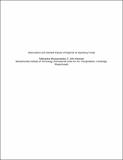Observations and Potential Impacts of Regional Jet Operating Trends
Author(s)
Mozdzanowska, A.; Hansman, R. J.
Downloadamerc-July2003-Montreal.pdf (95.14Kb)
Metadata
Show full item recordAbstract
Airlines are increasingly using regional jets to better match aircraft size to high value
demand markets, and reduce labor costs. This has been especially important due to the increased
pressure on the industry following September 11th 2001, because airlines see regional jets as a
major part of their financial recovery plan. The increase in regional jets represents a significant
change from traditional air traffic patterns and airline business models. To investigate the
possible impacts of this change, this study analyzed the economic characteristics of regional jets,
and well as the emerging flight patterns and performance of regional jets compared to traditional
jets and turboprops.
It was found that regional airlines have lower crew costs per number of block hours and take
offs, but higher crew cost per ASMs and RPMs. As a result, the revenues at regional airlines are
more susceptible to changes in crew cost. It was also observed that regional jets operate
differently then traditional jets. Regional jets increase the number of operations at airports and in
the take off tracks around airports, which may result in increased congestion. Regional jets were
also observed to exhibit lower climb rates than traditional jets, which may negatively impact air
traffic control handling and sector design. Given the possible economic and operational problems
associated with regional jets, their growth may pose unanticipated problems.
Date issued
2003-07Citation
Aviation Management Education and Research Conference ( AMERC), Montreal, July 2003.
Keywords
regional jets, labor costs, air transportation